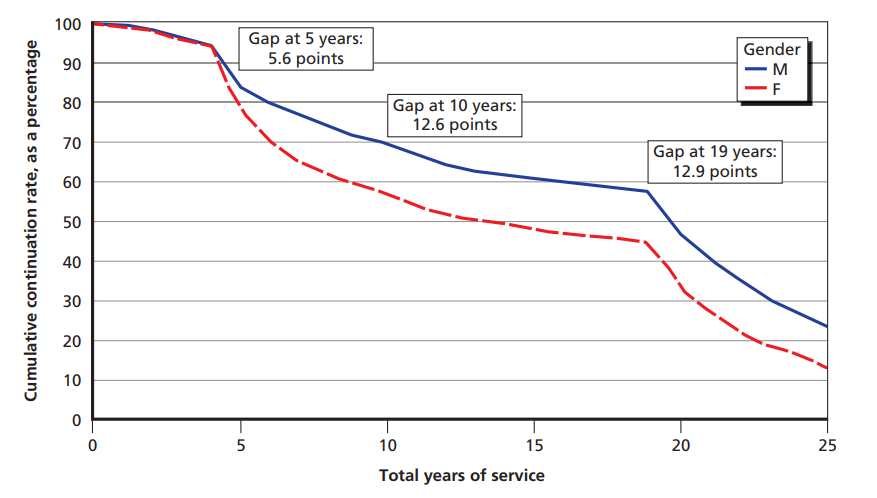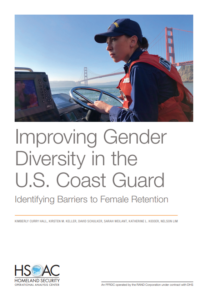US Coast Guard launched its first large-scale study on women’s retention in 30 years. The study was published as part of its commitment to create a more mission-ready workforce. The RAND Corporation report, ‘Improving Gender Diversity in the U.S. Coast Guard: Identifying Barriers to Female Retention,’ examined the root causes of women’s attrition and potential barriers to retention, as well as provided recommendations.
On average, female Coast Guard servicemembers depart the service earlier than their male counterparts, and the USCG as a whole is only 15% female.

Among enlisted personnel, 71.1% of men remain after four years of service compared with 62.4% of women, for a cumulative gap of 8.7% points. At both ten and 19 years—just before personnel become eligible for retirement—the gap is 12.3% points.
Moreover, the report lists the work environment factors according to which female focus group participants raised a number of them as influencing their retention decisions.
- Leadership: Female participants cited experiences with poor leadership as a factor in their retention decisions. They described perceptions of bad leaders being retained and even promoted; toxic commanders creating an “old boys’ club” environment that excludes women; examples of discrimination against women; and male leaders being reluctant to mentor women.
- Gender bias or discrimination: They characterised it as a strong contributor to women leaving the Coast Guard. Participants expressed the belief that they were treated differently than male peers, had to work twice as hard as men to prove themselves, and felt that men often did not trust their opinions or value the quality of their work. This was described as particularly pervasive in male-dominated ratings or specialties. Some women also perceived bias in evaluations.
- Weight standards: Female focus group participants frequently raised weight standards as a factor influencing their retention decisions. They perceived weight standards to be especially harsh for women compared with men. Women criticized the “taping” methods used to assess body fat because they do not take into account different female body types—women with wider hips that cannot be reduced by diet and exercise or body changes after childbirth—resulting in standards that are unreasonable and some- xiv Improving Gender Diversity in the U.S. Coast Guard times impossible for some women to meet. As a result, some women described resorting to crash diets and other unhealthy measures. Women also raised privacy concerns related to the taping process; taping is done by a yeoman and not a medical professional, and women have to undress for the procedure while men do not. Male focus group participants did not raise weight standards except to say they are more difficult for women to meet.
- Sexual harassment and assault: Female focus groups mentioned sexual harassment and assault as a retention factor. Participants stated that women who experience an incident of sexual harassment or assault in the Coast Guard may leave the service, with some participants relaying personal experiences of sexual harassment or assault but choosing thus far to remain. Some participants feared being assaulted while underway and mentioned that alcohol consumption during port calls can result in sexual assaults, with women typically being blamed for the incident.
As a participant commented
Women lose trust in command because they don’t take action despite numerous complaints and witnesses. They talk to the person, but it doesn’t result in paperwork or notification or change. So, people lose faith in commands. And then, they think the Coast Guard will be like that for the rest of their lives.
Another participant stated
Sexual harassment is the reason women get out. I was sexually harassed every day for two years. It was awful. People asked me why I didn’t speak up. I was 19. I thought I would lose the respect of my peers. If I report, half the unit would turn against me. . . . It creates a lot of animosity on the ship. . . . I wanted to get along with people. It was hard. It was the things they said right in front of me, and in front of other people who didn’t say anything.
- Workload and resource issues: Both women and men raised workload and resource issues as influencing retention decisions. Participants described consistently being asked to “do more with less” and feeling overworked. Often this is because of units reportedly being undermanned; resulting extra work hours can affect members’ worklife balance and lead to burnout. A lack of other types of resources—even simple office supplies—reportedly affected members’ ability to be effective at their jobs to the detriment of job satisfaction and morale.
Additional Factors include:
- Career factors such as Achievement, Assignments and Civilian opportunities;
- Personal Life factors as Spouses and partners, Children, Pregnancy, Breastfeeding support, and other personal life factors.
Based on these findings, the study recommended initiatives to improve women’s retention regardless of marital and parental status. It also recommended actions to retain a diverse workforce, such as updating its personnel management systems, augmenting workforce gaps during parental leave and expanding opportunities for comprehensive leadership development training.
- Update Coast Guard personnel management systems to better meet the needs of the Coast Guard’s current and future workforce;
- Explore options to augment unit human capital during parental leave;
- Explore options to minimize the impact of parental leave on evaluations and promotion;
- Continue to explore solutions to improve child care 0ptions;
- Consider modifying the weight and body fat standards program to minimize potential negative impacts on female members;
- Continue to explore creative solutions to female berthing limitations;
- Develop and implement a communication plan to ensure all members are aware of relevant policies and priorities, and strengthen leadership education to foster inclusive work environments;
- Communicate and educate leaders and members on female-specific Coast Guard policies;
- Expand opportunities for comprehensive Coast Guard leadershi development training;
- Emphasize to assignment officers the importance of assignment policies designed to meet the needs of members’ personal lives;
- Promote accountability and monitor effectiveness by establishing and tracking relevant metrics;
- Continue to monitor retention trends and track reasons for attrition;
- Ensure workforce data track relevant variables in a comprehensive manner.
Concluding, Adm. Charles W. Ray, Vice Commandant of the Coast Guard commented
Although the Coast Guard enjoys one of the highest retention rates among the five military branches, we must do better. This study is an important element in our broader effort to recruit and retain an inclusive and diverse workforce that reflects the American public we serve. It is every leader’s responsibility to identify and eliminate elements of our culture that may inhibit equal participation and opportunity in our Service.
For more information, click on the PDF herebelow





























































